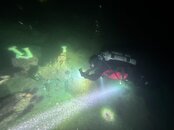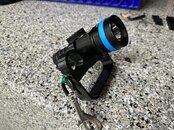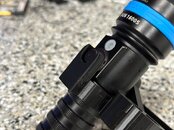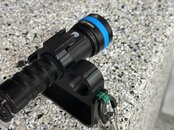Like ahereng said it's a generic light made to spec I think in China for our LDS here in Oslo. I can't recommend buying it from abroad as Norwegian prices are pretty high.Thank you very much for everyone's insightful replies. They will really help in my decision-making.
Your rationale makes a lot of sense to me; if I can keep from losing an expensive light, it makes me reconsider my stance against can lights.
Where did you obtain your light? I'm searching for DiveXtra and it's taking me to a page with only scooters. Anybody have any suggestions for similar (wireless v canister option) lights?
You are using an out of date browser. It may not display this or other websites correctly.
You should upgrade or use an alternative browser.
You should upgrade or use an alternative browser.
DIR views on non-canister primary lights
- Thread starter landlockeddivingdoc
- Start date
Please register or login
Welcome to ScubaBoard, the world's largest scuba diving community. Registration is not required to read the forums, but we encourage you to join. Joining has its benefits and enables you to participate in the discussions.
Benefits of registering include
- Ability to post and comment on topics and discussions.
- A Free photo gallery to share your dive photos with the world.
- You can make this box go away
OP
landlockeddivingdoc
Registered
That's good to know. In Dress For Success, it says of canister lights:...my instructor wanted me to use a corded light in order to learn cord management. It is especially important to learn when donating gas so you don't trap the long hose with the light cord.
"To prepare for use:
• Unclip the light head
• Remove the double ended bolt snap and
stow
• Pass the light head underneath the long
hose
• Grasp the Goodman handle with the left
hand."
Overall didn't seem too intimidating, but the part about the long hose did catch my eye. I guess it's not a terribly complicated task, but tasks add up, which was another reason i wasn't keen to be wrapped up in something else.
JoeTPhilly
Contributor
Here are a few videos which you might like:That's good to know. In Dress For Success, it says of canister lights:
"To prepare for use:
• Unclip the light head
• Remove the double ended bolt snap and
stow
• Pass the light head underneath the long
hose
• Grasp the Goodman handle with the left
hand."
Overall didn't seem too intimidating, but the part about the long hose did catch my eye. I guess it's not a terribly complicated task, but tasks add up, which was another reason i wasn't keen to be wrapped up in something else.
@landlockeddivingdoc , I believe most or all GUE instructors still want students to learn to use a corded light, the theory being that you don't want to be flustered if you have to borrow one. But outside of the class environment handheld lights are increasingly popular with GUE divers as they are for other tech divers. Personally, I still prefer a corded light because, like others here, I find it reassuring to have that expensive light head tethered to me.
As for handling that cord during, say, an S-drill, it may not seem "intimidating," but it's surprisingly easy to forget a step. It just takes practice. Even after years of practice, I still occasionally mess up, and it takes me a few seconds to fix it.
Taking a step back, I may have overlooked it, but you didn't mention what you plan to use your "primary light" for in the meantime--before you take Fundies. And you said you don't really have your sights set on tech diving. If you're diving locally in low-vis lakes, maybe doing multiple dives a day, then I suppose you would indeed want some kind of powerful, long burn-time light. But for diving in clearer waters, I'd stick with a nice inexpensive light until I really needed something blindingly bright with longer burn time for tech diving or at least for long dive days at low-vis sites. Economical lights like those from Dive Gear Express have more than enough power and burn time for most rec diving. For that kind of diving, I use two identical lights, and whichever one is in my hand is my "primary" and the other one, stowed on my BC, is my "backup."
As for handling that cord during, say, an S-drill, it may not seem "intimidating," but it's surprisingly easy to forget a step. It just takes practice. Even after years of practice, I still occasionally mess up, and it takes me a few seconds to fix it.
Taking a step back, I may have overlooked it, but you didn't mention what you plan to use your "primary light" for in the meantime--before you take Fundies. And you said you don't really have your sights set on tech diving. If you're diving locally in low-vis lakes, maybe doing multiple dives a day, then I suppose you would indeed want some kind of powerful, long burn-time light. But for diving in clearer waters, I'd stick with a nice inexpensive light until I really needed something blindingly bright with longer burn time for tech diving or at least for long dive days at low-vis sites. Economical lights like those from Dive Gear Express have more than enough power and burn time for most rec diving. For that kind of diving, I use two identical lights, and whichever one is in my hand is my "primary" and the other one, stowed on my BC, is my "backup."
Gelirfella
Contributor
Great thread. I have an old 21w LM HID light that I’m planning to use for fundies that I got on here for relatively cheap. The cannister is huge as it’s the old 3.5 inch beast, but I find I don’t really notice it underwater. I assume this will be fine for the purposes of fundies?
Of course that will be fine for Fundies class. Some people even prefer HID over LED for its beam quality or color or something. Maybe it's like vinyl records!Great thread. I have an old 21w LM HID light that I’m planning to use for fundies that I got on here for relatively cheap. The cannister is huge as it’s the old 3.5 inch beast, but I find I don’t really notice it underwater. I assume this will be fine for the purposes of fundies?
So I'm looking to buy a primary for night rec diving, but would like one that can "grow with me." I don't immediately plan to do any tec diving, but might do a GUE fundamentals course if the opportunity presents, and don't know if that'll change the trajectory of my diving.
I've looked through the many Scubaboard threads about specific light recommendations, and don't want to necessarily repeat that question (though, since I'm sure some will ask, I've narrowed it down to the LX20, CX2, and D630). Rather, I'm curious if someone can respond to the following with their experience and rationale:
1) How does the contemporary DIR community view non-canister primaries in general?
2) Do they still insist on a hard Goodman handle rather than a soft Goodman? If so, why?
I have read Jablonski's book, as well as MacKay's Dress for Success. The latter is a bit dated, referencing only HID lights over halogen, but nothing about LED illumination, and lists having a canister battery as something a light "should have." As technology has changed so much over the last decade or so, some smaller handheld lights (not necessarily those listed above) seem to give canister lights a run for their money, and I seem to gravitate to that option (I really don't like being wrapped up in any more wires or hoses than necessary), but I'd prefer to not be made fun of for not having something meeting minimum standards...there's plenty more I should be made fun of for!
There is a time and a place for both corded and cordless lights. That being said, a cordless light usually doesn't have a sufficient burn time for a full day of diving. Even the 5.2ah focus 2s don't always have enough burn time if you're doing multiple dives in a single day. To get those bigger battery packs on a cordless light, the light head starts to become heavier and becomes more in the way.
Most handhelds have about a 2.5-hour burn time. If you're doing something like a C1 class, you might spend 4 hours in the water daily. Even just doing two 1-hour dives in a single day brings you pretty close to the battery's endurance, and conducting burn tests on the light becomes more important.
Corded lights are also wonderful because you can't drop them, which I've seen people do a few times. Missing the clip when stowing the light, having it come off somewhere when stowed, or the cave line breaking or coming loose from the tie-offs can all lead to loss. It's reassuring to have that $1500 light actually attached to you.
As for soft vs. hard Goodman handle: You engage in a lot of passive light communication where you park your beam next to your team's beams so that you know the team is still all together. Any sort of erratic light motion will draw attention from the team because it becomes atypical. So having it slide off easily is nice to avoid erratic light signals.
You don't use the Goodman handle on your left hand in case you need to donate; you don't want to blind an OOG diver by pointing your light directly at his face. For scootering, you can still look around and signal without coming off the trigger.
But on your right side are all your buoyancy controls and your SPG, so you're frequently transferring the light to the temporary hold position in your right hand to do situational awareness checks and adjust buoyancy. Using a hard Goodman handle makes this much easier because of how easy it is to slip it on and off your hand.
Gone for diving
Contributor
You could use a piece of cord with a loop on it to bolt snap it on, to make it corded like a canister.The cordless is easier to travel with as it is very compact and is enough for my diving. However, at times I wish I had a corded version.
I wouldn't recommend it though...
Just a side note / tangent, but this is not current procedure, in GUE at least. The light cord goes outside the long hose. It means there is a slight dance with the cord when deploying the full length of the long hose to an OOA diver, but it prevents mistakenly trapping the long hose when clipping off the light.Pass the light head underneath the long
hose
If you want an inexpensive light that works extremely well as a DIR-compliant cordless light, the XTAR D26 1600S has an extremely tight beam, runs off 21700 rechargeable cells, and mounts easily to a Goodman handle. The whole setup (light, handle, 2 x 21700 batteries, excellent-quality charger, and bolts for attaching to the handle can be had for ~$120 USD, price fluctuations depending.
If you can find someone with a 3D printer, you can also print the top half of the handle you see below (and attach it to the Aliexpress handle I linked) to get yourself a nice thumb loop and a guard for the power button (which otherwise likes to be inadvertendly pressed).
Picture of the light beam in use last night also attached. It's an absurdly tight beam, with a brighter spot than anything I've seen except a Focus 2.0. A couple of people locally have used the D26 1600S for Fundies, and I use mine more often than my canister light for rec and T1 dives.
If you can find someone with a 3D printer, you can also print the top half of the handle you see below (and attach it to the Aliexpress handle I linked) to get yourself a nice thumb loop and a guard for the power button (which otherwise likes to be inadvertendly pressed).
Picture of the light beam in use last night also attached. It's an absurdly tight beam, with a brighter spot than anything I've seen except a Focus 2.0. A couple of people locally have used the D26 1600S for Fundies, and I use mine more often than my canister light for rec and T1 dives.
Attachments
Similar threads
- Replies
- 4
- Views
- 742
- Replies
- 18
- Views
- 1,081







